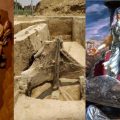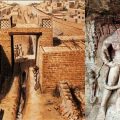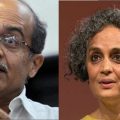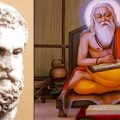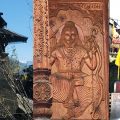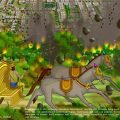Arundhati and Vasistha: The Dating of the Kurukshetra War, A Debate
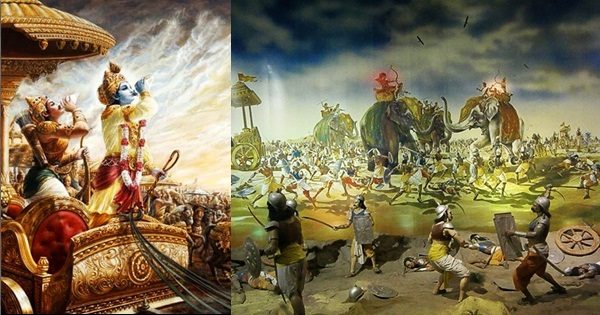
I am a former scientist in ISRO with background in space-craft navigation and trajectory design in the Earth-Moon system (done a project in this area as part of the Chandrayan 1 study phase in 2002 with appreciation from Dr APJ Abdul Kalam). This also trained me to design a space-craft trajectory anywhere inside the solar system with a decent awareness on the movement of planets in their orbits.
Being a researcher focusing on the Geographical Data in the Mahabharata, Ramayana and Itihasa Puranas, the date of Kurukshetra War, the birth of Krishna, Rama and other Aitihasic events are collaterally important for me. Hence, since 2010 I am interacting with various archaeo-astronomers and researchers who have come up with one or other dates for the Kurukshetra War. This include Sri Narhari Achar, Sri Manish Pandit, Sri Nilesh Oak, Sri Jayasree Saranath, Sri Vedaveer Arya, Sri Ashok Bhatnagar, Sri Ramamoorthy, Sri Mohan Gupta, Sri BB Lal, the proponents of the dates proposed by Pandit Kota-venkatachalam and so on. I had face to face discussions or email exchanges with all of these researchers in the last decade and have noticed their arguments in favor of their chosen date and also analyzed other facts that goes against or in favor of their arguments.
The Kurukshetra War dates proposed by these researchers generally fall into these categories:- 1. Dates around 5000 BCE and beyond. 2.Dates around 3000 BCE. 3. Dates around 2000 BCE. 4.Dates around 1000 BCE. The reason for such variance in the dates of archaeo astronomers is that, the planetary configurations observed in the terrestrial sky is cyclic in nature, because all the planets are moving around the sun in precise orbits in precise orbital periods, providing cyclic-nature to the planetary clustering in the various zodiacal zones (Rashis) of the terrestrial equatorial sky. Archaeo-astronomers arrive at any given Kurukshetra War date by correlating the astronomical observations (the positions of the known planets and comets, often with respect to the known stars or with the known constellations) found in the Mahabharata Samskrt text (most of the observations being that of sage Vyasa, close to the start of the Kurukshetra War) with the software generated sky charts. The software used for this usually comes under category of ‘planetarium software’ like ‘Stellarium’ which can calculate and visualize the terrestrial sky charts of past millennia from any given latitude and longitude on Earth. The ‘Panchanga software’ like ‘Jagannatha Hora’ which can calculate and provide the tithi, nakshatra and other astrological elements are often used in conjunction. The researchers also take into account the planetary positions with respect to the stars and constellations during a heroes birth or death or other important events in their life to supplement and strengthen the astronomical observations of Vyasa close to the start of the Kurukshetra War.
All of this is called the literature-astronomy correlation or the correlation of astronomy data in the Mahbharata (especially those close to the Kurukshetra War narrative) with a computed ancient planetary position chart (or with a computer generated ancient sky map).
Any given Kurukshetra War date cannot be considered as the final answer, purely on the basis of literature-astronomy correlation. In other words, literature-astronomy-correlation is not the final word here. This is because, each archao-astronomer uses plenty of assumptions while arriving at the date. For example, the stellar observation frameworks like the zodiac with its current names, the names of stars, planets and comets as we know now has undergone evolution. There is no guarantee that the terms used by Vyasa (like sweta-graha – the white planet for example) actually is self-same as what a modern archaeo astronomer means by that same term. Because of this, I treat an entire research work of an achaeo astronomer as a ‘black-box’ and only evaluate the final date that he or she is coming up with other factors, to see if the date is agreeing with these other important factors.
The following are these other important factors that need to agree with a given archaeo-astronomy date (no matter how it is arrived, and how many number of literature to astronomy correlations are provided by the researcher or how nicely they are matched):- 1. Yudhisthira-Kshemaka generation gap, 2. Evolution of chariots, 3.Evolution of Samskrt language, 4.Evolution of Sarasvati River 5. Dwaraka excavations, 6. Other factors like evolution of monsoon climate in north India (climatology) and evolution of the shore-lines of India due to sea level rise causing submergence and re-emergence of Dwaraka (bathymetry).
1. Yudhisthira-Kshemaka generation gap:- The cumulative life-time of kings from Yudhisthira (who took part in the Kurkshetra War) onward up to his 29th descendant viz. Kshemaka who was defeated by the Magadha king Mahapadma Nanda (BCE 450-BCE 362) is of great importance. Average generation gap between kings can be taken as 25 to 35 years. This demands that Yudhisthira must be living 29 x 25 = 725 or 29 x 35 = 875 years before Kshemaka in 1175 BCE or in 1325 BCE. A Kurukshetra War date proposed nearer to these dates is by archaeologist Prof BB Lal based on his excavations of Ayodhya, Kashi, Kausambi, Ahichatra, Hastinapura and Indraprasta. This date proposed by BB Lal is around 900 BCE. It is however not an archaeo-astronomy date and so it lacks the literature-astronomy correlation. Among all the archaeo-astronomy based dates (that I have reviewed), the dates that agree close with this Yudhisthira-Kshemaka generation gap are the one by Sri Krisna Ramamoorthy (1504 BCE) and another by Sri Ashok Bhatnagar(1792 BCE). The Yudhistira-Kshemaka generation gap can be extended if we consider that there are a few unknown generations in between, say around 10 more minor kings which could extend the cumulative generations gap from 29 generations to 39 generations. This extends the cumulative generation gap to 39 x 25 = 975 or 39 x 35 = 1365 years. So Yudhisthira can be living anywhere between 1425 BCE to 1815 BCE agreeing with archaeo-astronomy dates like 1504 BCE (Ramamurthy) and 1793 BCE (Bhatnagar). It is true that we are doing a little stretching (29 to 39 = 34% stretch in the number of generations and 25 to 35 = 40% stretch in the average gap in years between generations) on the Yudhisthira-Kshemaka cumulative generation-gap to accommodate the archaeo-astronomy based dates of Ramamurthy and Bhatnagar. But imagine the kind of stretch we need to accommodate Sri Nilesh Oak’s archaeo-astronomy date of 5561 BCE. If we go by an average generation gap of 25, it will require 204 generations between Yudhisthira and Kshemaka! 600% increase!. If we go by a gap of 35 then it will take 146 generations! 400% increase!. There is another development which tries to date Sri-Buddha from around 350 BCE to 900 BCE etc changing the date of Nanda etc along with it. But such re-dating of basic sheet anchors of accepted history is not fully conclusive and such dates only add around 600 years into this equation. This will benefit only dates like that of Ramamurthy (1504 BCE), Bhatnagar (1792 BCE) or that of Achar (3067 BCE) by reducing the stretch required on the Yudhisthira-Kshemaka cumulative generation gap, but has no helping impact on the date proposed by Nilesh at 5561 BCE.
2. Second issue is the evolution of the chariots. The critical invention that allowed the construction of light, horse-drawn chariots was the spoked wheel. The earliest spoke-wheeled chariots are dated to 2000 BCE. This means that a Kurukshetra War placed at 5561 BCE will be a war without the spoked light weight chariots driven by war horses, as detailed well in the Mahabharata in so many verses. The dates of Bhatnagar (1792 BCE) or any date lower than that doesn’t suffer that problem.
3. The third issue is the evolution of Indo European languages in which Samskrt language is a member and Mahabharata is authored in Samskrt language. As per linguistic theory which is agreed upon even by Indian linguists like Srikant Talageri (so it is not just a Eurocentric concept) who has proposed an Out of India IE linguistic theory based on it, the proto Indo European language evolved from around 5000 BCE to 4000 BCE period. Vedic Samskrt as attested in RgVeda, the oldest Indo-European literature is a daughter language of proto Indo European and it is outrageous to propose that Vedic Samskrt is older than 4000 BCE or 5000 BCE. Thus Nilesh Oak’s 5561 BCE date is beyond the acceptable evolution history of IE languages and Samskrt Language. Even otherwise, every language including Samkrt undergoes evolution. Due to this the names of people fashionable in one millennium goes out of fashion and out of use in another millennium. The usage of the word denoting night ‘nakta’ became unpopular and the word ‘ratri’ is used instead as centuries passed by. The meaning of ‘asura’ which included even Indra changed and later ‘asura’ meant only the enemies (Daitya, Danavas etc). Even the grammatical forms undergo evolution, not just the meaning and the popularity of of nouns. This is why RgVedic Samskrt is different from Ramayana Samskrt and both are different from Kalidasa Samskrt. So if Kurukshetra narrative is as old as 5561 BCE, most of the narrative would have become unrecognizable by now due to 7000 years of language evolution. Kurukshetra war dates at 1792 BCE or lesser doesn’t have any problem agreeing with the evolution of Samskrt or of IE family of languages.
4. Most reliable archaeologist concur that the drying up of Sarasvati began around 4000 years ago, i.e. around 2000 BCE. The Kurukshetra War dated around 1792 BCE or later agrees fully with this scenario since Balarama was traveling along a partially dried up Sarasvati river starting from Dwaraka and reaching finally at Kurukshetra on the 18th day of Kurukshetra War. During 5561 BCE Sarasvati was not likely a dried up river, like it is well detailed in the Balarama travel narrative (which is the subject of my geographical research and a topic in several of my research papers).
5. Dwaraka underwater excavation by Dr SR Rao and his daughter Dr. Nalini Rao place the dating of Dwaraka ruins to between 1500 BCE and 2000 BCE. The date of Dr Bhatnagar (1792 BCE) and Ramamurthy (1504 BCE) falls in this range. Nilesh Oak’s date of 5561 BCE is too far.
6. Climatology and bathymetry studies too can give valuable indirect information to accept or reject pure archaeo-astronomy dates which have only literature-astronomy-correlation to its merit and so not a final word for the acceptable date of Kurukshetra War. Since five other factors are sufficient to reject the date proposed by Nilesh (5561 BCE) i am not dwelling into the details. But generally speaking, the monsoon timings with respect to the equinox / solstice positioning revealed from the narrative of Mahabharata, implies dates like those proposed by Bhatnagar.
Apart from these above 5 or 6 crucial issues that rules out a 5561 BCE date for Kurukshetra War, I have gone further and found some fatal flaws in the archaeo-astronomy dating related steps that he followed. The error he makes is at the very first step. The selection of the initial time sector based on the Arundhati-Vasistha (AV) observation.
The two stars Arundhati and Vasistha are now identified as a part of a multiple star system. They have a mutual orbital motion typical of multiple star systems. So to a terrestrial observer Arundhati can appear as positioned ahead of Vasistha (or Vasistha can appear as positioned ahead of Arundhati) due to the changing position of Arundhati in its orbit around the center of the multi-star-system. Since the orbital period is very long, till almost around 4000 BCE Arundhati was ahead of Vasistha and after that Vasistha became ahead of Arundhati, like it is now. Nilesh went by the statement of Vyasa in Mahabharata, that Arundhati is found as moving ahead of Vasistha and deduced that Kurukshetra War has to be placed in the time sector preceding 4000 BCE. I contested it and said, Arundhati-Vasistha observation is not a reliable astronomy data which can be used for Mahabharata dating, because it is clubbed with another observation that, the dark mark on the moon has shifted. The rabbit shaped dark mark on the moon will never appear as shifted unless there are some atmospheric disturbances. Vyasa tells about both (Arudhati is moving /positioned ahead of Vasistha and the mark on the moon has shifted) as if they both happened suddenly close to the start of the Kurukshetra War! But since based on Nilesh’s own admission, Arundhati was indeed positioned ahead of Vasistha for so many years (not just moments, days, or months, but years!) from around 11500 BCE to around 4000 BCE, there is no reason why Vyasa would talk about it in 5561 BCE as an unusual observation, because it was the norm for so many years and centuries. But in the period after 4000 BCE (when Vasistha was relatively positioned ahead of Arundhati), due to some freak atmospheric effect, Arundhati can momentarily appear as positioned ahead of Vasistha and also the mark on the Moon can momentarily appear as shifted / deformed. Though not in the case of the Moon, but in case of a distant star like the Arundhati and Vasistha, interstellar lensing effect can do the same trick. Some inter-stellar cloud remnant or a faint star / planet in random orbits can intercept the line of vision between the Arundhati-Vasistha star system and Vyasa can notice an apparent shift in the relative position of stars (momenterily or for a few days or months).
This is the context of my Facebook discussion with Nilesh Oak that you can see below. In fact there were two discussions, one in the Facebook wall of Dr Subhash Kak and another during the Indic Talk of Nilesh Oak arranged by Indic Academy in Facebook:
01/12/2017
On Subhash Kak’s FB wall:
Jijith Nadumuri Ravi (addressing Subhash Kak): You will be happy to know about this new archao-astronomy based date of Kurukshetra war arrived at by Dr Ashok Bhatnagar, an astronomer himself, which gives a date of 1793 BCE for the Kurukshetra War. The uniqueness of this date is that it is within the range of the modern archaeological findings of Archaeological Survey of India formerly headed by Prof BB Lal (who, with his team of archaeologists has done the equivalent of unearthing the Troy of Greek epic fame, by unearthing many Mahabharata cities like Ayodhya, Indraprasta, Kampilya, Ahichatra, Hastinapura, Kausambi etc. and who himself gave a date of 850 BCE to 900 BCE to the war, based on the information available at that time) and which has now expanded its archaeological research horizon, pushing the possible archaeology compatible dates of the War to as early as 2136 BCE (with a Painted Gray Ware – PGW site unearthed near Alamgirpur dated to 2136 BCE).
Thus we see the Harappan culture of Sarasvati-Yamuna blending with the PGW culture of Sarasvati-Yamuna-Ganga, which can be corresponded to the Vedic era blending with the Aitihasic Kurukshetra War era. Thus the dating problem of Kurukshetra War is nearly solved. But sure the date at which Mahabharata text became structured in the way it is available to us is different from the date of Kurukshetra War. Mahabharata, as you said contain the events like the birth of ancient ancestors like Yayati, Nahusha, Ayu, Pururavas, Ila and Manu can very well be placed in older millennia. In my paper presented at Indraprasta Conference in 2016, I correspond these ancestors with the sites like Rakhigarhi (4600 BCE) and Bhirrana (7570 BCE). Similarly after the War, we have the descendants like Parikshit, Janamejaya, Satanika Ashvamedhadatta, Asima, Nichakra (who shifted capital from Hastinapura to Kausambi due to Ganga-floods) and up to Kshemaka mentioned in MBH, Harivamsha and Vishnu Purana constitute the later kings who has to be assigned to dates after 1793 BCE and it may run to as late as 200 BCE. But axis mundi of Mahabharata is the Kurukshetra War and so the date of Mahabharata is to be taken as primarily as the Kurukshetra War which is described in the bulk of its 18 parvas, starting from 6th (Bhishma Parva) to 10th (Sauptika Parva) and narrated by Sanjaya to Dhrtarashtra which is the core that the original Vyasa composed as Jaya, which ever be the number of verses contained in this Jaya. It is Jaya (Sanjaya-Dhrtarashtra dialog) which is to be understood as Itihaasa in its normal sense as ‘it thus happened’, as if narrating the events happened before the very eyes of the narrator. Other narratives such as the life of ancestors like Yayati and Upakhyanas like that of Nala, Savitri and others and numerous sub narratives and stories found in MBH has to be then seen as Puranas.
Deepa Bhaskaran Salem (addressing Nilesh Nilkanth Oak): See above comment. Familiar with this work?
Nilesh Nilkanth Oak: He remains tight-lipped and not someone open to logical discussions and/or debate. Be it as it may, the very year of 1793 BCE can be instantaneously falsified by AV observation.
In addition, I came to know of his claimed day for Bhishma Nirvana and it can be shown to be decisively false.
This is what I wrote in evaluating Ashok Bhatnagar’s Bhishma Nirvana claim, in my book Bhishma Nirvana.
Bhishma Nirvana claim: 20 December 1793 BCE – Gregorian reference calendar. Ashok Bhatnagar proposed 14 October 1793 BCE as the first day of Mahabharata war. This means the 10th day of war when Bhishma fell in the battle was 23 October 1793 BCE. Shri Bhatnagar claimed 20 December 1793 BCE as the day of Bhishma-nirvana. The day happens to be Magha Shukla 9.
The motivation to select 24 December appears to be driven by his desire to corroborate the selective reference of 58 days, i.e. from 23 October through 20 December and selective reference of Magha Shukla 8. He shows ignorance of 59 additional chronology observations of Bhishma-nirvana. The day of 20 December 1793 BCE is within +/-1 day of the day of winter solstice. Thus, Bhatnagar’s claim scores 2 points.
In a tennis parlance, he scored 2 points with his claim. He lost 59 points.
Jijith Nadumuri Ravi: Here is a repeat of what I mentioned in your Facebook talk questioning the validity of AV observation in Kurukshetra War dating. AV is not a useful data-point that can be used for Kurukshetra War dating due to this problem:
या चैषा विश्रुता राजंस तरैलॊक्ये साधु संमता
अरुन्धती तयाप्य एष वसिष्ठः पृष्ठतः कृतः
32 रॊहिणीं पीडयन्न एष सथितॊ राजञ शनैश्चरः
वयावृत्तं लक्ष्म सॊमस्य भविष्यति महद भयम
Arundhati and Vasistha seems to have misled you!
It is only a single verse at 06.02.31 which means Arundhati keeps Vasistha on her back. The immediate verse (32) says The Deer-sign in the Moon has deviated from its usual position!
So this is some aberration of observation due to atmospheric effects. Because deer sign in the moon cannot shift unless if there is an observation aberration due to atmospheric effects like haze, cloud cover etc.
Certainly no one can base their entire thesis on Astronomical Dating of Mahabharata war on a fragile observation like this.
Astronomical phenomena are cyclic in nature. Hence, the correlation of astronomical observation found in Mahabharata to ancient sky maps through archaeo-astronomy and planetarium software too repeat. Thus it is repeated in around 2000 BCE (leading to work of Ashok Bhatnagar), around 3000 BCE (leading to the work of Dr Achar) and in around 5600 BCE (leading to the work of you and Vartak).
In this only Ashok Bhatnagar’s works correlate well with archaeology (works of Dr BB Lal, Dr KN Dikshit and Dr BR Mani) and literature (Puranic king list).
I also then pointed out to you that, at your Kurukshetra War date of 5561 BCE, Vasistha moving behind Arundhati was not an ‘unusual’ observation at all, so that Vyasa would notice it and report it. Here is my whole comment:
06.02.31
या चैषा विश्रुता राजंस तरैलॊक्ये साधु संमता
अरुन्धती तयाप्य एष वसिष्ठः पृष्ठतः कृतः
06.02.32
रॊहिणीं पीडयन्न एष सथितॊ राजञ शनैश्चरः
वयावृत्तं लक्ष्म सॊमस्य भविष्यति महद भयम
Look at the two verses. Verse 06.02.31 says Arundhati keeps Vasistha on her back. Verse 06.02.32 says the mark on the moon has shifted.
You interpret the first verse as ‘Arundhati walking ahead of Vasistha’ or ‘Vasistha walking behind Arundhati’ which is fair enough. In our times, Vasistha is walking ahead of Arundhati, but you discover that between 11091 BCE to 4508 BCE period, Arundhati was indeed walking ahead of Vasistha. Then you deduce that the war must have happened some day between 11091 BCE to 4508 BCE. Then you narrow down the date to 5561 BCE using other datable astronomical references in MBH like Bhishma Nirvana.
My point is that this Arundhati Vasistha observation is not a datable astronomical reference. It is clubbed with this other undatable observation viz. the shifting of the mark on the Moon. Mark on the moon (a rabbit shaped dark patch) stays unchanged on the Moon’s face since Moon always shows the same face as it is tidally locked.
Both these observations (Vasistha behind Arundhati and shifting of the mark on the Moon) have other possible explanations like atmospheric-disturbances and lensing-effects (defraction of light in space while passing through extra-terrestrial gas clouds).
Besides, Vyasa was reporting all the unusual changes in the sky where these verses are found.
You yourself say that for many years since 11091 BCE to 5561 BCE (your proposed date of the War) (and up to 4508 BCE) Vasistha moved behind Arundhati.
So why would Vyasa, all of a sudden, in 5561 BCE, report it as unusual, when it was just the norm then for many years?
Such an observation is unusual only in the epoches younger than 4508 BCE, (which includes 1792 BCE) where, like today, Arundhati is moving behind Vasistha. Then, due to some atmospheric effects or lensing effects, if it appeared otherwise, Vyasa would find it unusual and report it – like – ‘hay look! Arundhati is moving ahead of Vasistha!’
Hence instead of choosing the time sector 11091 BCE to 4508 BCE, you should have chosen the time sector younger than it, like from 600 BCE to 4508 BCE to narrow down to the final Kurukshetra War date using other datable references like Bhishma Nirvana. In this younger time-sector, archao-astronomical sky-maps reveals two clusters of dates suitable for MBH War dating with most of the datable astronomical observations in MBH matching quite well – one around 3100 BCE and another around 1800 BCE. Of this, Dr Achar is using the first one, arriving at a date of 3067 BCE and Bhatnagar is using the second one arriving at 1792 BCE. In this, Bhatnagar’s date has the support of archaeology with antiquity of PGW crossing the 2000 BCE timeline with its 2136 BCE dated sites.
Nilesh Nilkanth Oak: What is the excavation data found by archaeologists? How did they relate it to the timing of Mahabharata? and What inferences did they draw? Why? and how?
Nilesh Nilkanth Oak (addressed to Deepa Bhaskaran Salem): Please do read two previous posts by Jijith Nadumuri Ravi ji. What he states is also been stated by few who would be considered poster boys by Hindu side. The level of scholarship is at this level. Tragic yet real. In any case, it allows us to set the baseline (corporate speak) and to improve from there. A long way to go!
Jijith Nadumuri Ravi ji refuses to read either my books or blogs and keeps on misrepresenting my work. To be fair, he is asking questions or raising wild and irrelevant objections allows me an opportunity to revisit the subject for the benefit of masses. He is referring to FB live chat I had some time ago viaIndic Book Club.
I do thank him for his persistence. This is because every time he does it, it presents me with an opportunity to explain my findings.
The link to my IBC FB chat is here:
Nilesh Nilkanth Oak (addressed to Jijith Nadumuri Ravi): What prevents you from sticking to the subject? I critiqued specific claim of Ashok Bhatnagar for the day of Bhishma-Nirvana. Do you have anything to say in defense of Bhatnagar ji?
30/07/2017
During the Fb talk of Nilesh facilitated by IBC/ Indic Academy:
Jijith Nadumuri Ravi (addressed to Nilesh Nilkanth Oak): As I mentioned before Dr Bhatnagar is ready to debate with you in a forum of archao-astronomers and archaeologists. I clarified it to you before. I am focusing on the broader consensus of multiple disciplines like archaeology and archao-astronomy which eluded all reconciliation till Bhatnagar came with his date of 1793 BCE. Won’t give much importance to each and every ambiguous astronomy observations in Kurukshetra war like AV. Your specific question such as on Bhishma-nirvana will be answered by Bhatnagar in such a forum. He has rejected some astronomical observations as ambiguous and non-datable (like the AV, whose issue I mentioned above). Will check with him where Bhishma-nirvana falls in his scheme of things. The final date he gives viz. 1793 BCE is indeed solving the most important issue of reconciliation with archaeology. I give a lot of importance to it than in dating every vague and unclear astronomy information mentioned in Mahabharata.
Nilesh Nilkanth Oak (addressed to Jijith Nadumuri Ravi): If he goes for arbitrary and selective evidence, I do not have any time to debate with such ‘Superficial and manipulative claims’.
If you are convinced of his work, present his work in all its glory. All the best.
Jijith Nadumuri Ravi: He is not selecting arbitrarily. A criteria is applied if a given astronomical observation in MBH is clear or ambiguous. Clear data points are selected, ambiguous ones are rejected. AV is an ambiguous one, which I have shown clearly in my comments above. I look forward for an enriching conversation between you and Dr Bhatnagar in an appropriate forum.
How do you reconcile your 5561 BCE Kurukshetra War date with the Puranic Kinglist which cannot expand to 5000 years? How do you reconcile it with the absence of archaeological evidence in the Mahabharata cities – Ahichatra, Kampilya, Indraprasta, Hastinapura, Virant Nagari etc at 5561 BCE? Archaeologists find nothing in these places at 5500 BCE or beyond. So the date 5561 BCE creates more problems than it solves. How do you solve this?
Nilesh Nilkanth Oak: The problem of LACK of archaeological evidence is true for any proposal of Mahabharata war. What is so special about 5561 BCE?
Jijith Nadumuri Ravi: Lack of archaeological evidence is a problem for older Kurukshetra War dates like 5561 BCE but not for younger dates like 1793 BCE. Painted Gray Were (PGW) culture identified by Dr BB Lal as the cultural remains of Mahabharata cities (Indraprasta, Hastinapura, Ahichatra, Kampilya) has expanded its time-span to as old as 2136 BCE. So an Kurukshetra War date of 1793 BCE, like the one proposed by Bhatnagar (using the same archaeoastronomy that you use) has the support of archaeology.
Nilesh Nilkanth Oak: Absence of evidence is NOT evidence of absence.
Jijith Nadumuri Ravi: Dr Ashok Bhatnagar is an astronomer himself and his date 1792 BCE for Kurukshetra War correlate well with archaeology and with Puranic king list than all the older MBH dates including yours. This was appreciated by Dr BB Lal (archaeologist), Prof Valdia (geologists who discovered drying up of Sarasvati by 2000 BCE) and by Dr Nalini Rao (who gave a date of 1500 BCE to 2000 BCE for the submergence of Dvaraka). So all jigsaw puzzles are finally getting solved by Bhatnagar’s date of 1792 BCE with archaeology, geology, archaeo-astronomy and literature coming together and converging to dates around 1792 BCE or roughly around the 18th century BCE. I will introduce him to you and would like to know your review of his work and his review of your work.
Please also see Dr BB Lal’s archaeology field work. How do you reconcile your work with his?
Nilesh Nilkanth Oak: If 1792 BCE solves all the puzzles, all power to this date. Do explain how this date does solve all these jigsaw puzzle. Until then, do not spread wrong information.
Dharma jago NivruttichA I
Hari nAme utsAho II
Jijith Nadumuri Ravi:
या चैषा विश्रुता राजंस तरैलॊक्ये साधु संमता
अरुन्धती तयाप्य एष वसिष्ठः पृष्ठतः कृतः
32 रॊहिणीं पीडयन्न एष सथितॊ राजञ शनैश्चरः
वयावृत्तं लक्ष्म सॊमस्य भविष्यति महद भयम
Arundhati and Vasistha seems to have misled you!
It is only a single verse at 06.02.31 which means Arundhati keeps Vasistha on her back. The immediate verse (32) says The Deer-sign in the Moon has deviated from its usual position!
So this is some abberation of observation due to atmospheric effects. Because deer sign in the moon cannot shift unless if there is an observation abberation due to atomospheric effects like haze, cloud cover etc.
Certainly no one can base their entire thesis on Astronomical Dating of Kurukshetra war on a fragile observation like this.
Astronomical phenomena are cyclic in nature. Hence, the correlation of astronomical observation found in Mahabharata to ancient sky maps through archaeo-astronomy and planetarium software too repeat. Thus it is repeated in around 2000 BCE (leading to work of Ashok Bhatnagar), around 3000 BCE (leading to the work of Dr Achar) and in around 5600 BCE (leading to the work of you and Vartak).
In this only Ashok Bhatnagar’s works correlate well with archaeology (works of Dr BB Lal, Dr KN Dikshit and Dr BR Mani) and literature (Puranic king list).
I fully admire your dedication on commitment on finding the Kurukshetra War date. But please do look at the work of Ashok Bhatnagar before you fully base your weight on AV observation and the MBH date on 5561 BCE.
Nilesh Nilkanth Oak: It is sad to see how ill informed you are about the chronology research of Kurukshetra war. Choice is yours, but start reading the works of Mahabharata researchers in the original to avoid making such erratic and nonsensical comments.
All the questions you asked and objections you raised were great and that made the live chat more productive. If you have these questions, we can be assured that many others, thinking like you or otherwise, may have similar or identical questions or objections. Thank you.
Jijith Nadumuri Ravi: For the true date of Kurukshetra War, both earth (dhara / terra) and sky (dyaus) the two eternal witnesses of all terrestrial events, should agree. The sky is represented by archaeo-astronomy and earth by archaeology. They both more or less agree for dates between 2000 BCE and 1000 BCE
Featured image courtesy: mahabharatastories.in.

